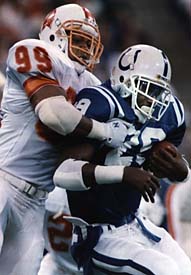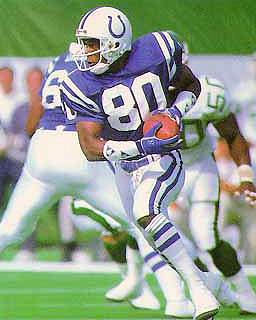 Latest Colts News Schedule & Weekly Recap Archive |
Descendants of the
Mayflower:
1984: A New Beginning After narrowing his choices down to Phoenix and Indianapolis, Robert Irsay picked up stakes and moved the team from Baltimore, where attendance was declining, to the new Hoosier Dome in Indianapolis, Indiana. Nearly a quarter of a million people welcomed the team and its owner as they arrived via moving van. While their surroundings changed, the club continued its losing ways, going 4-12 in its inaugural season in Indianapolis. From 1984-1986, the team never won more than five games in a season and never finished higher that fourth in the AFC East, going 12-36 during that span. Irsay also went through four coaches (Frank Kush, Hal Hunter, Rod Dowhower and Ron Meyer) during that time. 1987: The Year of the Trade In a strike-shortened season, the citizens of Indianapolis finally had something to cheer about. Ron Meyer, who had saved the franchise from a winless season (and eternal embarrassment) by coaching the team to three wins to end the 1986 season season, guided the Colts to the AFC East crown with a 9-6 record. Key to the season was the acquiring Eric Dickerson from the Rams on Halloween. The Colts went 6-3 after Dickerson arrived, and the SMU graduate led the AFC in rushing despite playing in only nine games. It was the first time the Colts had made the playoffs in 10 years; for his efforts, Meyer won the AFC's Coach of the Year award. Unfortunately, the club's postseason dreams were dashed early, losing to the Cleveland Browns 38-21 in the first round of the playoffs.
The following year, the Colts post their second straight winning season with a 9-7 record, but failed to make the playoffs. Eric Dickerson led the AFC in rushing yardage for the second straight year, gaining a team record 1,659 yards. 1991: Put a Stamp on This Year and Mail it in After a couple years of slow decline, the wheels came off on the Indianapolis franchise in 1991. Head coach Ron Meyer resigned (some say he was fired) after five games and was replaced by Rick Venturi, who would later achieve similar futility with the New Orleans Saints. Indianapolis finished the season 1-15, their worst record since going 2-12 in 1974. The team also scored just 143 points, the lowest total ever in a 16 game season.
1992: The Return of Coach Ted In 1992, Ted Marchibroda was hired to bring back to see if he could work the same magic he wrought with the Colts in the mid- to late 1970s. It worked well the first year, as Indianapolis went 9-7, but the team struggled the next year, falling to 4-12. Overall, Indianapolis went an uneventful 21-27 during the first three years of Marchibroda's second term as head coach. During this time, however, Bill Tobin was brought in to take charge of player personnel decisions. Through his wisdom (which has now come under much scrutiny), the Colts acquired such players as Jim Harbaugh, Marshall Faulk, Sean Dawkins and Zack Crockett, and a number of ex-Chicago Bears such as David Tate, Troy Auzenne and Chris Gardocki. Faulk, the number two overall pick in the 1994 draft, became the first Indianapolis player to be named Rookie of the Year and made the Pro Bowl, rushing for 1,282 yards. 1995: Captain Comeback and the Cardiac Colts Craig Erickson, acquired in a draft-day trade with Tampa Bay, turned out to be a colossal bust and one of the worst decisions made by the front office in recent years. Jim Harbaugh, who had been relegated to the bench behind Erickson, became the starting quarterback in game 3 of the regular season and had one of the most memorable seasons in Colts history, leading the team to a 9-7 record, including a regular-season win over the defending champion San Francisco 49ers. During the season, Harbaugh engineered four fourth-quarter come from behind wins, earning him the nickname "Captain Comeback." He finished the year with a quarterback rating of 100.7, earning his first spot in the Pro Bowl. The Colts turned in a Cinderella-like performance in the postseason, beating both San Diego and Kansas City on the road before succumbing to Pittsburgh on a last-second Hail Mary pass. Despite the loss, Harbaugh established himself as the team's leader, earning Comeback Player of the Year honors from the Pro Football Writers of America. Marshall Faulk and left tackle Wil Wolford were also named to the Pro Bowl. Despite the success on the field, it was a time of turmoil in the front office. Defensive coordinator Vince Tobin left the team to accept the head coaching position at Arizona. Ted Marchibroda, who was offered only a one year contract extension, resigned his position and became the head coach of the Baltimore Ravens. Offensive coordinator Lindy Infante took over the dual role of head coach and coordinator for the following year. 1996: In Like a Lion, Out Like a Lamb The Colts started off 1996 the same way they finished 1995, with a dramatic season opener decided on the last play against Arizona. The "Cardiac Colts" opened the season 4-0, with wins over the Jets in New York and a stunning, 25-24 upset win over the defending Super Bowl champion Dallas Cowboys in Texas Stadium. After such a meteoric rise, however, the team began to struggle as injuries decimated the roster. No team in the league suffered more injuries than the Colts in 1996. Marshall Faulk missed large blocks of playing time with a toe injury; even when he could play, he was rarely at his full abilities. Harbaugh, playing behind a makeshift offensive line, spent much of the season either running for his life or on his back, and was sacked a league-high 36 times. Through it all, though, the team still made its way into the playoffs with a 9-7 record. The 1997 rematch with the Pittsburgh Steelers was nothing like the previous year's championship game, however. In the end, the Colts were simply outmuscled by the bigger, stronger and healthier Steelers, as the team lost 42-14 in the first round of the playoffs. Despite the loss, there were some personal highlights for the Colts. Cary Blanchard set an AFC record for most field goals made in a season (36) and broke the team record for field goals and points scored in a season (135), making the Pro Bowl for the first time. Punter Chris Gardocki also made the Pro Bowl. And rookie receiver Marvin Harrison was named the "Special Teams Player of the Week" during November due to his blossoming return skills. 1997: Season of Changes It was supposed to be the year everything came together. Instead, it all fell apart. Before the season even began, four players who had started on the team that made the AFC Championship game -- linebacker Jeff Herrod, defensive lineman Tony Siragusa, and defensive backs Ray Buchanan and Eugene Daniel -- were either waived by general manager Bill Tobin or signed with other teams. Each player's leaving had a major impact on the team's chemistry. Within the span of a few weeks, two of the Colts' most outspoken players were gone. Especially hard on the run defense was the loss of Siragusa, who was also one of the Colts' most vocal players and the glue that held the defensive line together. Worse than the loss of Siragusa was the treatment of Daniel and Herrod, who were unceremoniously let go prior to the start of the season. Both men were quiet veterans who had led the team not with their words, but their actions on the field. Herrod had led the team in tackles seven of the past eight years, and Daniel, the last remaining player from the original "Indianapolis" Colts, was on his way to breaking Johnny Unitas' record for most games played by anyone in a Colt uniform. But it was simply not to be. With the heart of the defense ripped from them, and an offensive line comprised of two rookies and a group of castoffs from other clubs, the team struggled mightily in 1997, losing their first 10 games of the season before knocking off the defending Super Bowl champion Green Bay Packers, 41-38. Poor line play on both sides of the ball led to the team's demise in 1997. With such a young, struggling offensive line, Colt quarterbacks were sacked a record 62 times. Each of the team's three starting quarterbacks -- Jim Harbaugh, Paul Justin and Kelly Holcomb -- suffered injuries of one form or another. On the defensive side of the ball, the loss of Siragusa was more than expected, as the Colts allowed their opponents to rush for more than 127 yards a game and allowed 46 touchdowns. As a result, the Colts finished the season at 3-13, their worst record since 1991. The team ended up allowing a record 62 quarterback sacks in one season, and the defense, while finishing eight in the NFL statistically, was one of just six franchises to allow more than 400 points on the board. Despite finishing with the worst record in the league, there were still a few reasons for Colt fans to have hope for next season. Running back Marshall Faulk seemed to have regained some of the form that made him the league's top draft pick in 194, hitting the 1,000 yard mark in rushing for the third time in four years. Marvin Harrison continued to prove that he was the best receiver taken in the '96 draft, catching a team-high 73 passes and scoring six touchdowns. And defensive end Dan Footman proved to be a steal in free agency, finishing 11th in the league with 10.5 quarterback sacks. In 1998, the Colts began a new era in Indianapolis by drafting quarterback Peyton Manning. The story of the Manning era and the Colts' revival in Indianapolis can be found on the following page. To read up on the Peyton Manning era, click here. For the complete history of the Colts (both in Baltimore and Indianapolis), click here. |
|||||

